Recent Work
The microscopic description of fission represents an extreme-scale application
of the nuclear Density Functional Theory (DFT). The quality of simulations strongly depends on microscopic input, e.g., the deformability
of the energy functionals. We have devoted a significant effort to
produce energy functionals that produce correct physics at large
shape elongations and develop numerical techniques and tools that would facilitate symmetry-free constrained DFT calculations.
A starting point in the adiabatic approach to fission is the capability to compute accurate
multi-dimensional potential energy surfaces (PES), and use them to compute
observables such as fission half-lives or fragment distributions.
This requires a
very versatile and efficient DFT solver. The workhorse of our fission work
is a 3D symmetry-free code
HFODD.
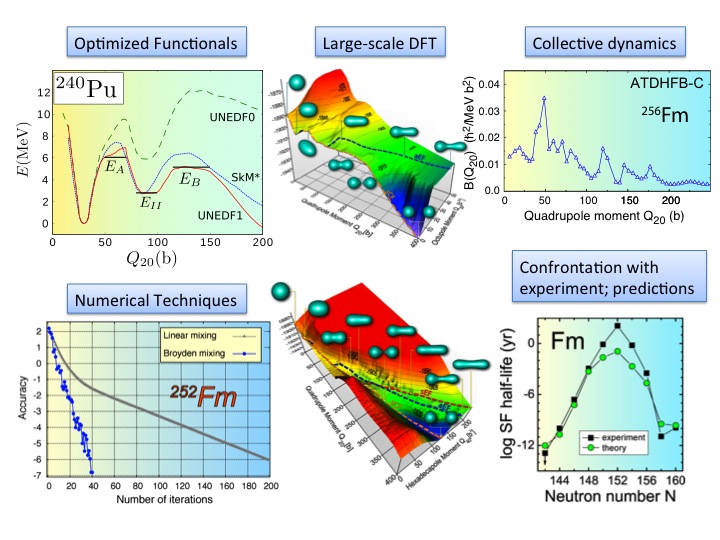
Figure 1: Our approach to fission. Calculations are based on quality density functionals optimized for large deformations (upper left) and state-of-the art numerical techniques (lower left). Large-scale DFT calculations in multidimensional collective spaces are needed to produce accurate potential energy surfaces, which enable to identify the multiple fission channels (middle). Based on this information, large-scale dynamical simulations are carried out to calculate fission lifetimes, fission fragment properties, and other observables (right).
We have studied the stability of our results
with respect to the number of deformed harmonic oscillator states used
in this basis. Figure 2 shows the calculated self-consistent potential
energy curve (PES) as a function of the axial mass quadrupole moment Q20
for 240Pu. The solid line corresponds to Nosc=1000 stretched harmonic
oscillator states included in the basis. The results with different
values of Nosc=680 (14 spherical oscillator shells), 816 (15 shells),
969 (16), 1140 (17), 1330 (18), 1540 (19), and 1771 (20) are also shown
at the extreme points (minima and maxima) of the PES. It is seen that
the convergence weakly depends on the quadrupole deformation, i.e., the
larger the elongation, the weaker the convergence. As shown in Fig. 2,
reliable calculations can be carried out with Nosc=17, and the
basis-stability error on the first and second barrier is less than 1
MeV.
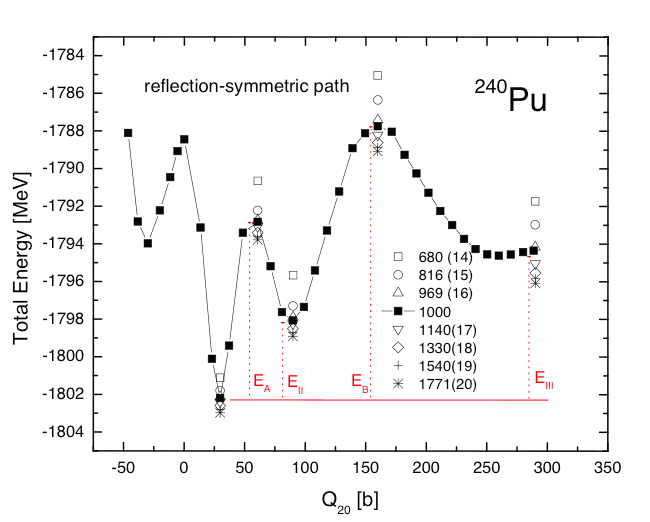
Figure 2:
Stability of the calculated HFB+BCS energy for 240Pu as a function of
the harmonic oscillator basis size.
References (selected):
- Skyrme-Hartree-Fock Calculations of Fission Barriers of the Heaviest and Superheavy Nuclei", A. Staszczak, J. Dobaczewski, and W. Nazarewicz, Int. J. Mod. Phys. E 14, 395 (2005).
- Fission Barriers of Superheavy Nuclei in the Skyrme-Hartree-Fock Model", A. Staszczak, J. Dobaczewski, and W. Nazarewicz, Int. J. Mod. Phys. E 15, 302 (2006).
- Deformed Coordinate-Space Hartree-Fock-Bogoliubov Approach to Weakly Bound Nuclei and Large Deformations," J. C. Pei, M. V. Stoitsov, G. I. Fann, W. Nazarewicz, N. Schunck, and F. R. Xu, Phys. Rev. C 78, 064306 (2008).
- Surface symmetry energy of nuclear energy density functionals", N. Nikolov, N. Schunck, W. Nazarewicz, M. Bender, and J. Pei, Phys. Rev. C 83, 034305 (2011).
Having determined the basis size, we performed a set
of calculations for the series of even-even fermium isotopes which are
experimentally known to exhibit rapid variations of the spontaneous
fission lifetimes and, in some cases, bimodal fission. In our
calculations, the quadrupole and octupole mass moments were used as
constraints. Two fission paths corresponding to bimodal fission have
been investigated. The 'usual' reflection asymmetric path corresponds
to two fission fragments with different mass. The reflection-symmetric
path can be associated with division into symmetric, nearly spherical
fragments with high kinetic energies. As seen in Fig. 3, the energy
barriers calculated for 252-260Fm have fairly similar shapes, with a
characteristic two-humped structure. Non-axial deformations are fairly
small and they are present only in the region of the inner barrier. For
the lighter isotopes, the reflection-asymmetric path is favored
energetically. The situation changes when approaching 264Fm,
where the
fission paths becomes symmetric.
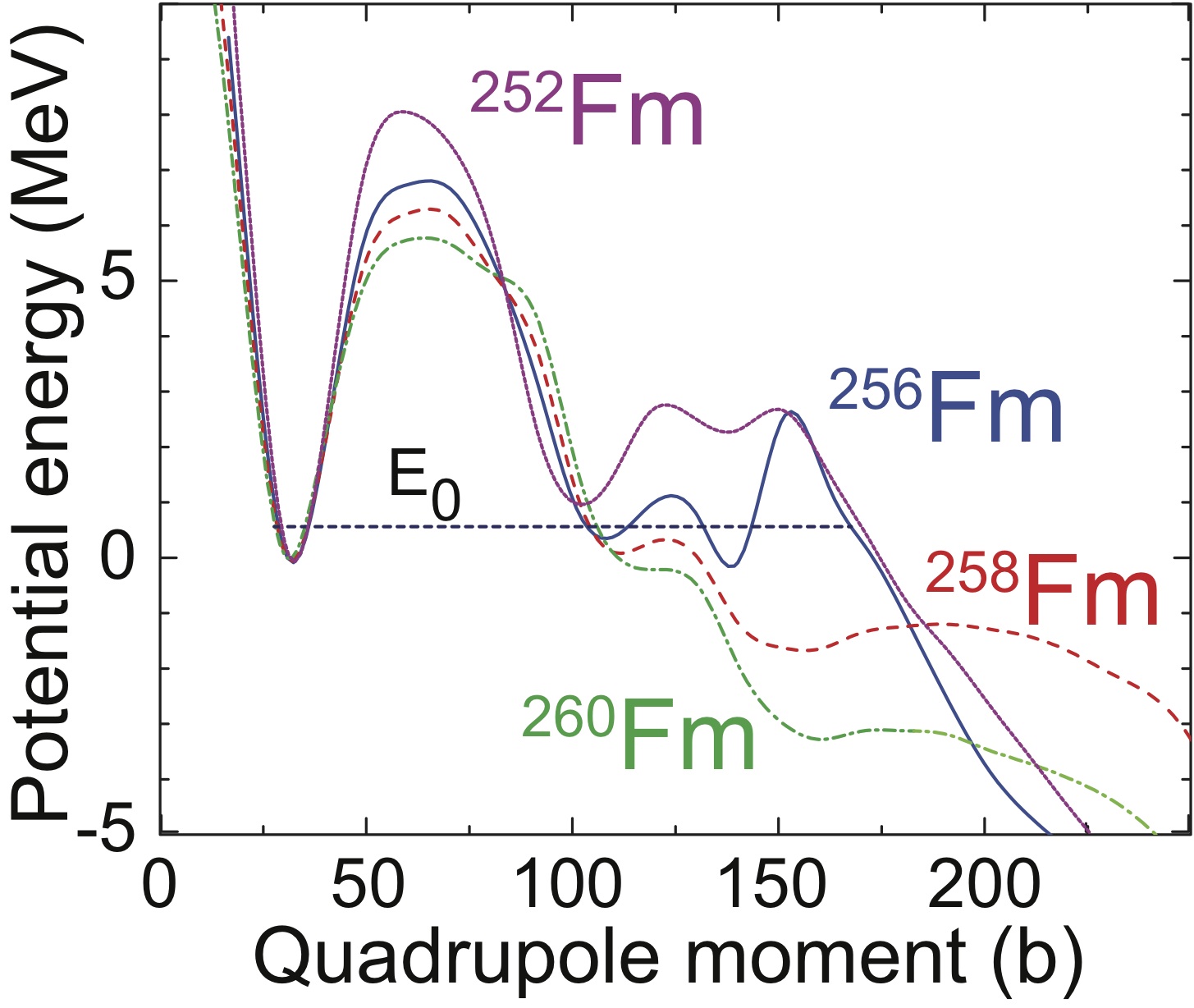
Figure 3:
Self-consistent potential energy surfaces for even-even fermium
isotopes 252-260Fm.
References (selected):
- Microscopic description of complex nuclear decay: Multimodal fission, A. Staszczak, A. Baran, J. Dobaczewski, and W. Nazarewicz, Phys. Rev. C 80, 014309 (2009)
- Bimodal fission in the Skyrme-Hartree-Fock approach, A. Staszczak, J. Dobaczewski, and W. Nazarewicz, Acta. Phys. Pol. B, 38, 1589 (2007).
Figure 4 shows the energy surface of the transuranic element 258Fm
calculated within the self-consistent nuclear density functional theory
with the SkM* functional as a function of two collective variables: the
total quadrupole moment Q20 representing the elongation of nuclear
shape, and the total octupole moment Q30 representing the left-right
shape asymmetry. Indicated are the two static fission valleys: (i)
asymmetric path aEF leading to asymmetric mass split of fission
fragments and (ii) symmetric-compact path sCF corresponding to a
division into nearly spherical fragments. Experimentally, a transition
is observed from an asymmetric distribution of mass splits in
neutron-deficient fermium isotopes to a more symmetric distribution when
getting closer to 264Fm. The density functional theory calculations
explain this phenomenon in terms of shell effects in the emerging
fission fragments approaching the doubly-magic 132Sn nuclei. In
calculations, all possible nuclear shapes, including triaxial and
reflection-asymmetric (pear-like) shapes, are allowed.
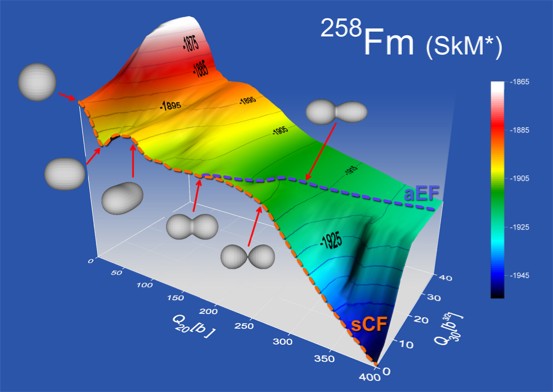
Figure 4:
Potential energy surface of 258Fm calculated in the symmetry-unconstrained
HFB theory.
Two fission valleys are indicated.
References (selected):
- Microscopic description of complex nuclear decay: Multimodal fission, A. Staszczak, A. Baran, J. Dobaczewski, and W. Nazarewicz, Phys. Rev. C 80, 014309 (2009)
- Bimodal fission in the Skyrme-Hartree-Fock approach, A. Staszczak, J. Dobaczewski, and W. Nazarewicz, Acta. Phys. Pol. B, 38, 1589 (2007).
A summary of our findings for the competition between fission pathways in the heaviest elements is given in
Fig. 5.
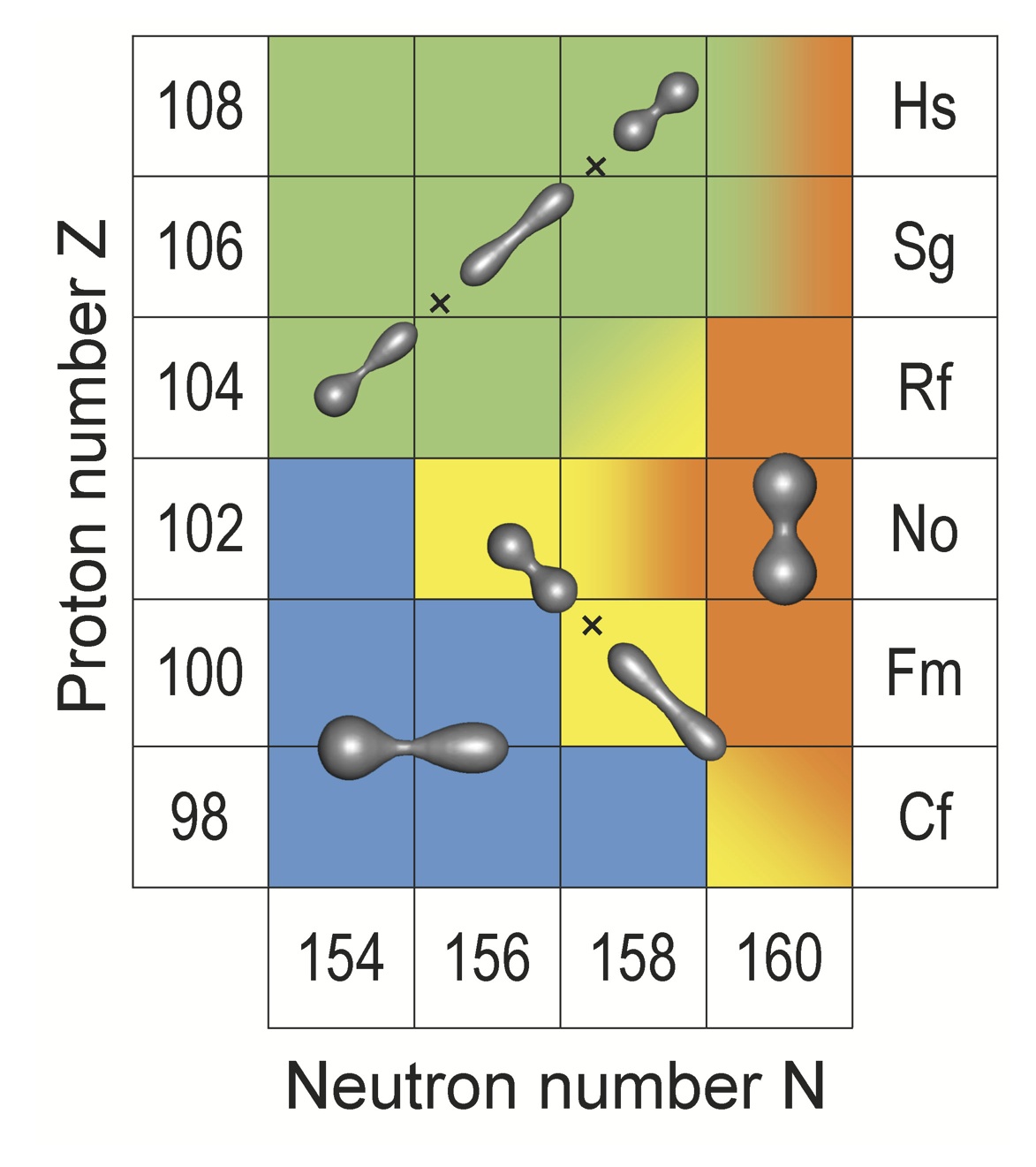
Figure 5:
Summary of fission pathway results obtained in our work. Nuclei around 252Cf are
predicted to fission along
the asymmetric path aEF; those around 262No along the symmetric
pathway sCF. These two regions are separated by the
bimodal
symmetric fission (sCF + sEF) around 258Fm. In a number of
the Rf, Sg, and Hs nuclei, all three fission modes
are likely (aEF + sCF + sEF; trimodal fission).
In some cases, labelled by two-tone shading with one tone
dominant, calculations predict coexistence of two decay scenarios
with a preference for one. Typical
nuclear shapes
corresponding to the calculated nucleon densities are marked.
References (selected):
- Microscopic description of complex nuclear decay: Multimodal fission, A. Staszczak, A. Baran, J. Dobaczewski, and W. Nazarewicz, Phys. Rev. C 80, 014309 (2009)
- Bimodal fission in the Skyrme-Hartree-Fock approach, A. Staszczak, J. Dobaczewski, and W. Nazarewicz, Acta. Phys. Pol. B, 38, 1589 (2007).
A new Skyrme-like energy density suitable for studies of strongly elongated nuclei has been determined in the framework of the Hartree-Fock-Bogoliubov
theory using the recently developed model-based, derivative-free optimization algorithm.
Figure 6 displays
the potential energy curve of 240Pu as a function of the mass quadrupole moment. Triaxiality and reflection asymmetry
effects are included. The large-deformation behavior of the potential energy curve obtained by the functional UNEDF0 is
typical in this region, so that the outer barrier heights obtained by UNEDF0 are systemmatically much higher than empirical values. We note that the UNEDF1 functional yields both the inner and outer barrier in 240Pu fairly close to experiment.
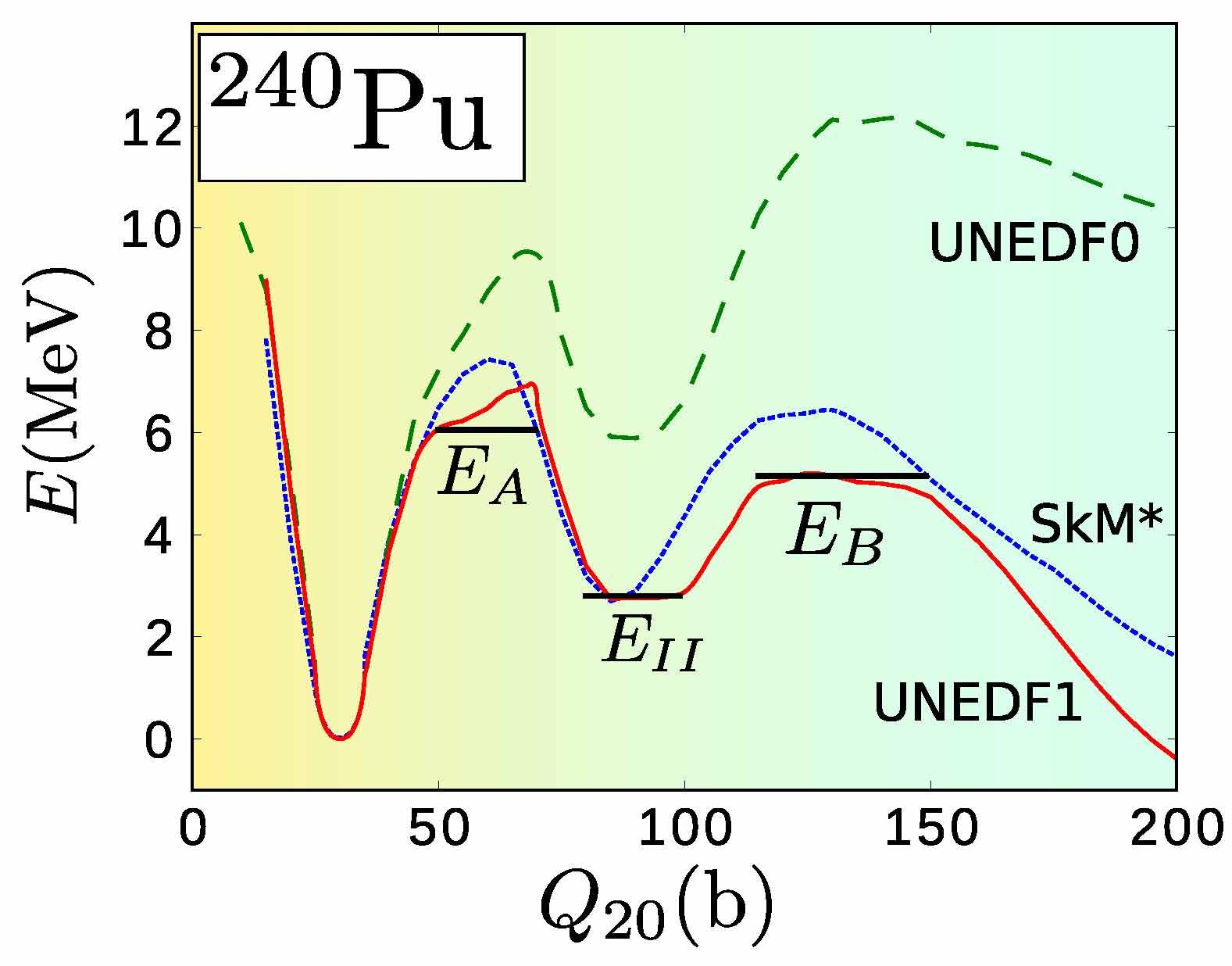
Figure 6:
Fission pathway for 240Pu along the mass quadrupole moment calculated with SkM*, UNEDF0, and UNEDF1 energy density functionals.
The ground state energies have been normalized to zero. E(II),
E(A), and E(B) indicate, respectively, the experimental energy of fission isomer and
the inner and outer barrier heights
References (selected):
- Nuclear energy density optimization: Large deformations", M. Kortelainen, J. McDonnell, W. Nazarewicz, P.-G. Reinhard, J. Sarich, N. Schunck, and M.V. Stoitsov. Phys. Rev. C (2012).
- Surface symmetry energy of nuclear energy density functionals", N. Nikolov, N. Schunck, W. Nazarewicz, M. Bender, and J. Pei, Phys. Rev. C 83, 034305 (2011)
The main theoretical input for an estimate of fission half-lives is
collective inertia (mass tensor) and collective potential.
Collective mass tensor derived from the cranking approximation to
the adiabatic time-dependent Hartree-Fock-Bogoliubov (ATDHFB)
approach has been compared with that obtained in the Gaussian Overlap
Approximation (GOA) to the generator coordinate method. It has been shown that the collective mass
exhibits strong variations with the quadrupole collective
coordinate, see Fig. 7. These variations are related to the changes in the
intrinsic shell structure.
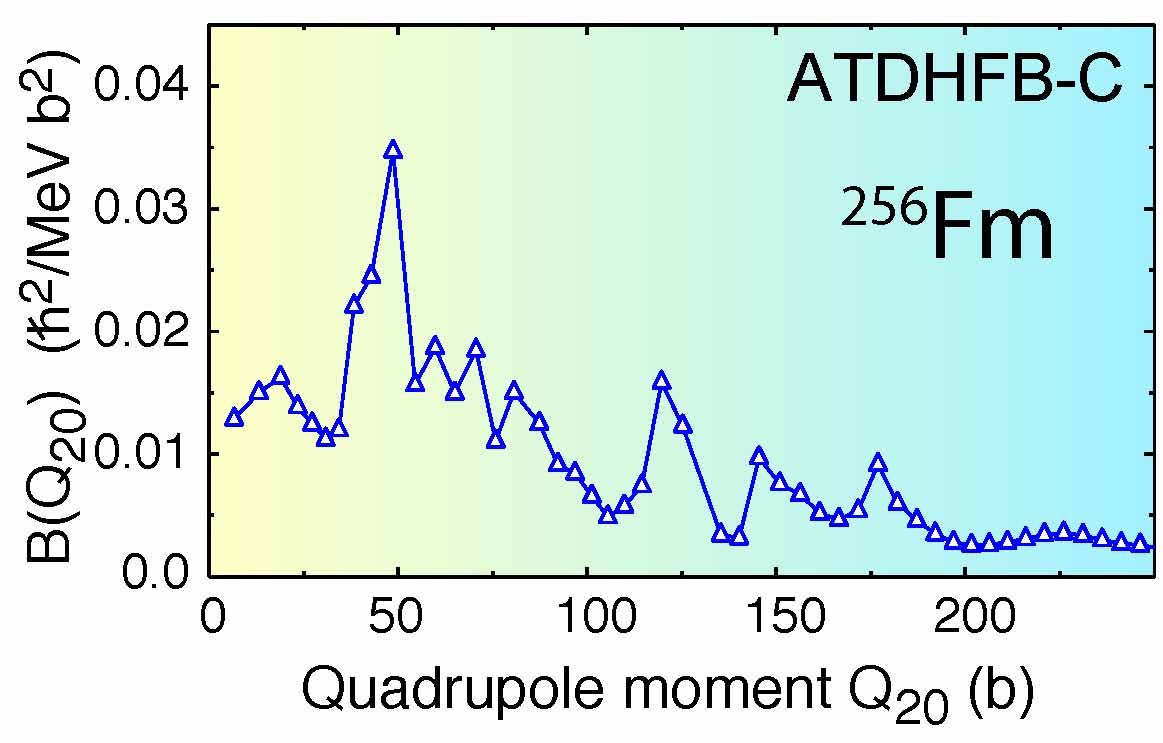
Figure 7:
The quadrupole mass parameter
in ATDHFB-C along the static fission pathway of 256Fm calculated
as a function of the mass quadrupole moment.
References (selected):
- Quadrupole collective inertia in nuclear fission: Cranking approximation", A. Baran, J. A. Sheikh, J. Dobaczewski, W. Nazarewicz, and A. Staszczak, Phys. Rev. C 84, 054321 (2011)
- Collective inertia and fission barriers within the Skyrme-Hartree-Fock theory", A. Baran, A. Staszczak, J. Dobaczewski, and W. Nazarewicz, Int. J. Mod. Phys. E 16, 443 (2007).
To assess the SF half-lives theoretically, we
calculated the collective inertia parameter along the quadrupole moment and
performed WKB barrier penetration calculations
for even-even fermium isotopes.
The
resulting SF half-lives are shown in Fig. 8.
In spite of a
fairly simple 1D penetration picture, it is satisfying to see a
quantitative agreement between experiment and theory. The existence of a small
outer barrier in 256Fm is significant as it increases the
fission half-life in this nucleus by more than four orders of
magnitude compared to that of 258Fm, thus explaining the rapid
change in experimental SF half-lives between these nuclei.
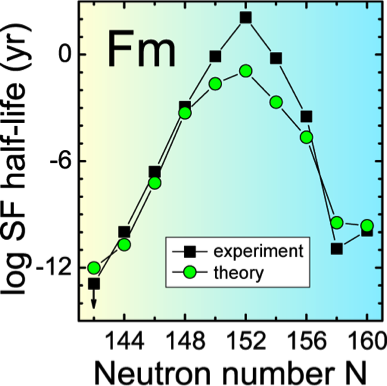
Figure 8:
Calculated fission half lives of even-even fermium
isotopes
compared with experimental data.
References (selected):
- Microscopic description of complex nuclear decay: Multimodal fission, A. Staszczak, A. Baran, J. Dobaczewski, and W. Nazarewicz, Phys. Rev. C 80, 014309 (2009)
- Fission half lives of fermium isotopes within Skyrme Hartree-Fock-Bogoliubov theory", A. Baran, A. Staszczak, and W. Nazarewicz, Int. J. Mod. Phys. E 20, 557 (2011)
We investigated the dependence of fission barriers on the excitation energy of the compound nucleus. In particular, we demonstrated the relationship between isothermal and isentropic description of fission and studied the isentropic fission pathways. Figure 9 shows the dependence of fission barrier of
264Fm on temperature. The survey of the barrier damping parameter obtained in our work is shown in Figure 10: it nicely illustrates the appreciable particle number dependence of barrier damping.
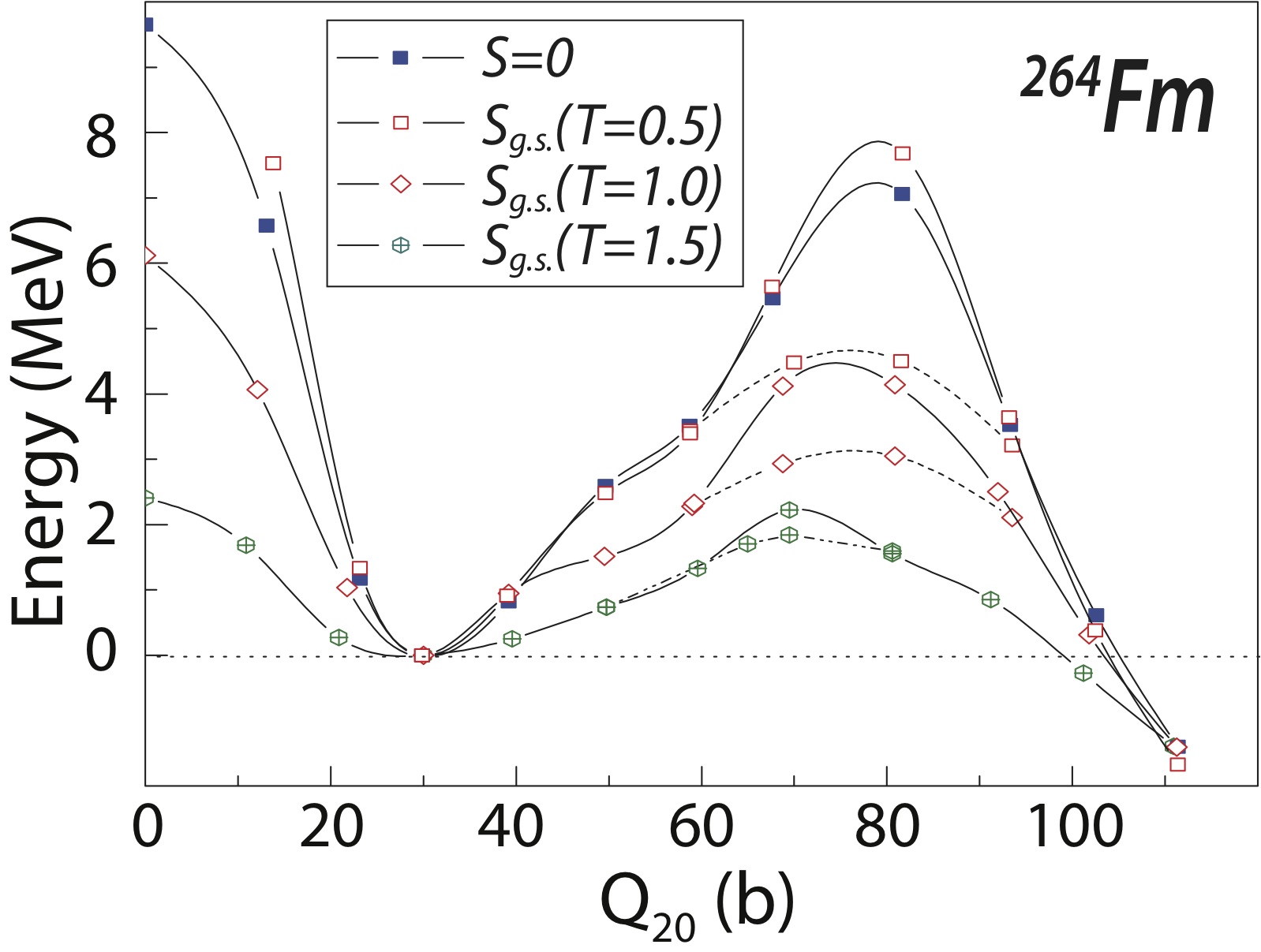
Figure 9:
Symmetric isentropic fission pathways
of 264Fm at the values of entropy S corresponding to temperatures
kT=0, 0.5, 1.0, and 1.5 MeV. The energy has been normalized to zero at
the ground-state minimum. The effect of triaxial degrees
freedom on the first barrier is marked by dashed lines.
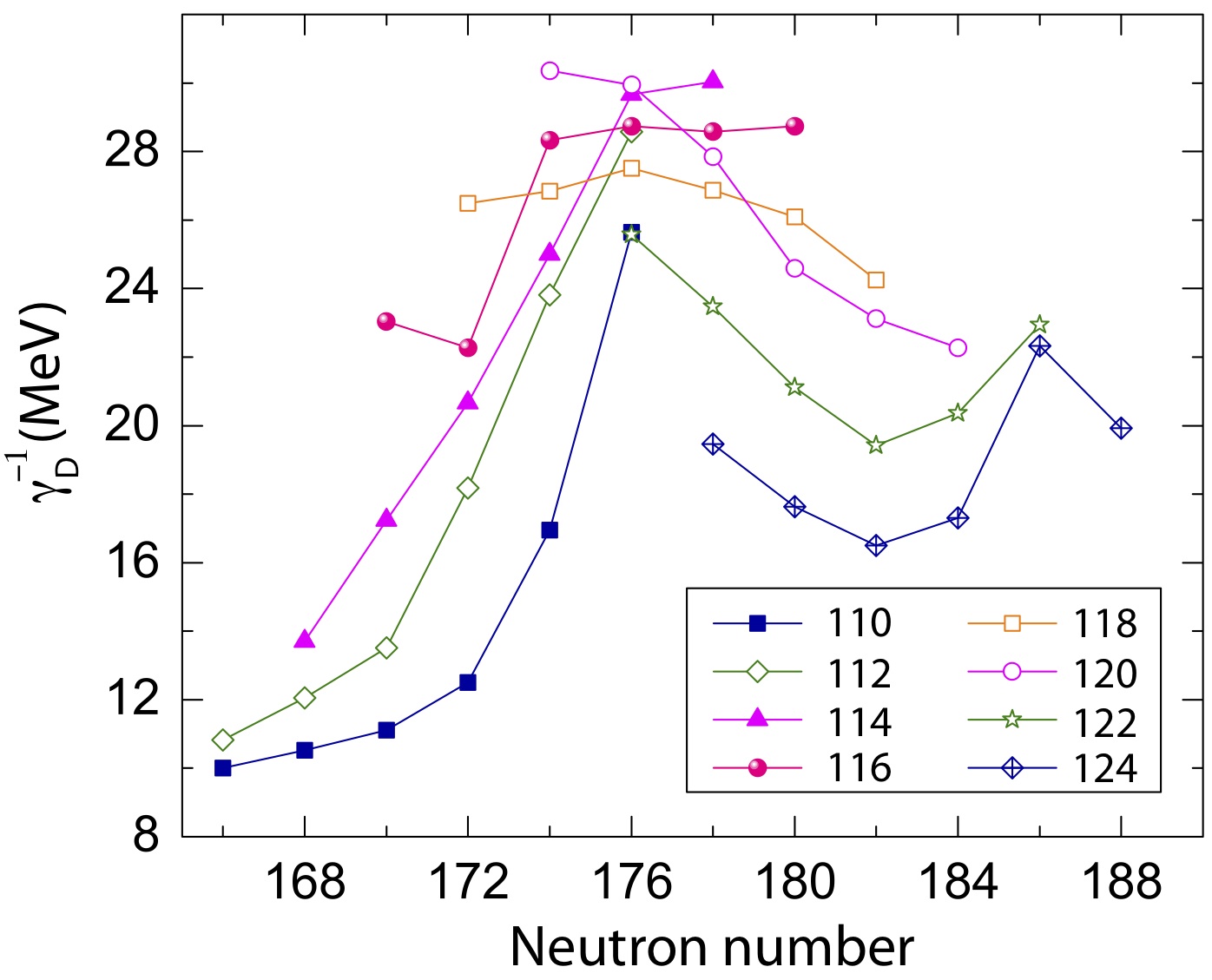
Figure 10:
Inverse barrier damping parameter extracted from
our calculations for 48 even-even superheavy nuclei.
References (selected):
- Fission barriers of compound superheavy nuclei, J.C. Pei, W. Nazarewicz, J.A. Sheikh and A.K. Kerman, Phys. Rev. Lett. 102, 192501 (2009).
- Systematic study of fission barriers of excited superheavy nuclei, J.A. Sheikh, W. Nazarewicz, and J.C. Pei, Phys. Rev. C 80, 011302(R) (2009)
- Fission barriers and neutron gas in compound superheavy nuclei, J.C. Pei, W. Nazarewicz, J.A. Sheikh, and A.K. Kerman, Nucl. Phys. A 834, 381c (2010).
We investigate the transition from asymmetric to symmetric
fission with increasing excitation energy. Experimental studies
indicate that there is a systematic increase in the
symmetric mass yield relative to the asymmetric one with excitation
energy. By calculating the reflection-asymmetric deformations along
static fission pathways, we show that such a transition indeed takes
place in selected nuclei.
In order to assess the impact of triaxiality on the first, and mirror asymmetry on the second saddle point, we computed the
non-axial (Q22) and reflection asymmetric (Q30) moments
along the optimal fission pathway of 240Pu for several temperatures, see Fig. 11.
The energy gain on the first barrier
due to triaxiality, quite appreciable at T=0, becomes practically negligible at kT=1.5 MeV while the corresponding quadrupole moment Q22 is nonzero even at
kT=2 MeV. This indicates that at large excitation energies the energy surface of 240Pu becomes very soft
in the triaxial direction.
A similar conclusion can be drawn for the reflection asymmetric degree of freedom Q30
and its impact on the outer barrier.
The results
displayed in Fig. 11 are consistent with the observed change in the pattern of fission yields. Indeed, at kT=2 MeV the calculated optimal fission pathway shows
a very weak octupole effect.
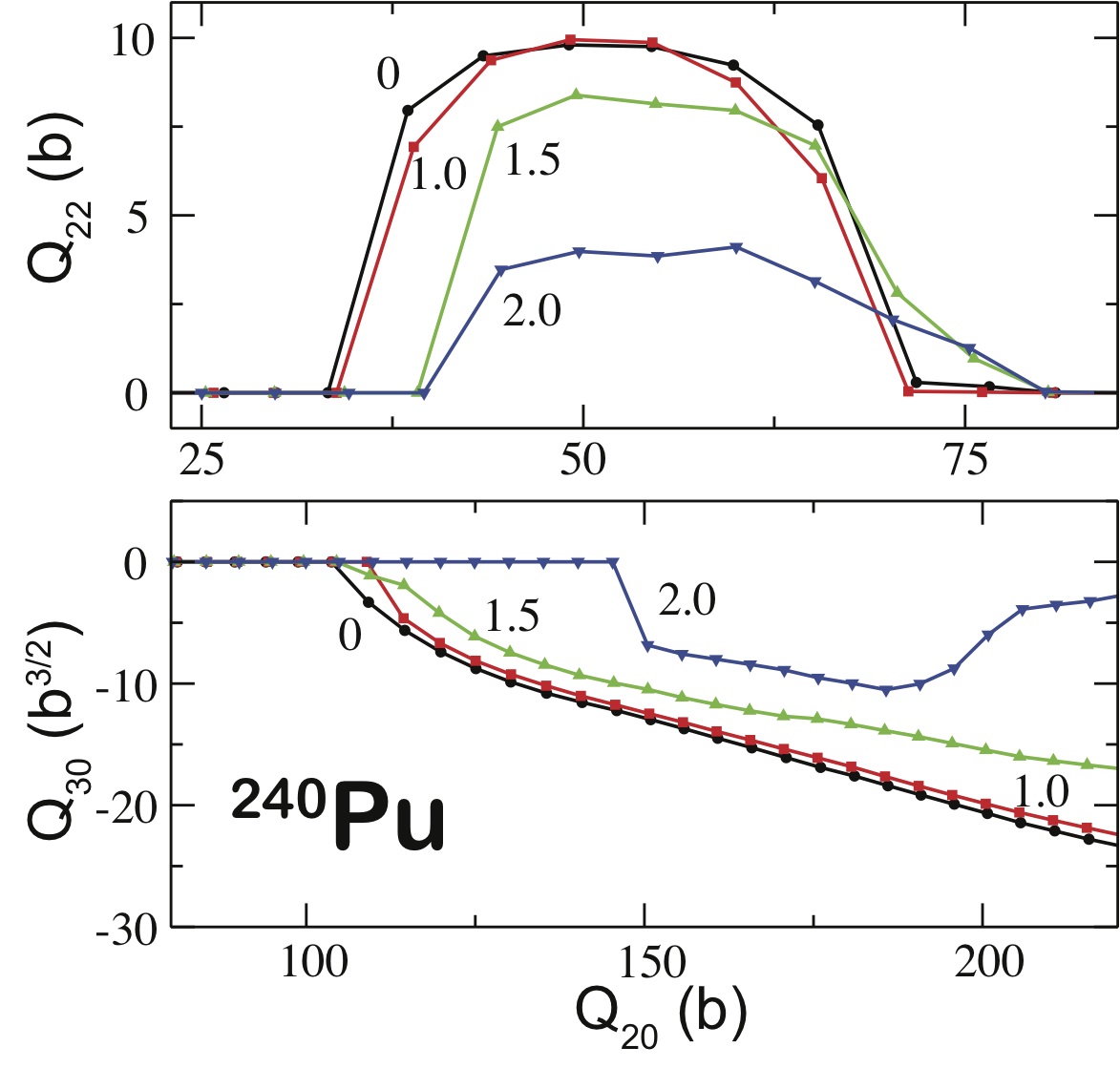
Figure 11:
Variation of non-axial, necking and reflection asymmetric as
a function of axial quadrupole field and temperature are shown
for 240Pu.
References (selected):
- Fission barriers of compound superheavy nuclei, J.C. Pei, W. Nazarewicz, J.A. Sheikh and A.K. Kerman, Phys. Rev. Lett. 102, 192501 (2009).
- Systematic study of fission barriers of excited superheavy nuclei, J.A. Sheikh, W. Nazarewicz, and J.C. Pei, Phys. Rev. C 80, 011302(R) (2009)
- Fission barriers and neutron gas in compound superheavy nuclei, J.C. Pei, W. Nazarewicz, J.A. Sheikh, and A.K. Kerman, Nucl. Phys. A 834, 381c (2010).
The spontaneous fission lifetime of 264Fm has been studied within nuclear density functional theory by minimizing the collective action integral for fission in a two-dimensional quadrupole collective space representing elongation and triaxiality. The collective potential and inertia tensor are obtained self-consistently using the Skyrme energy density functional and density-dependent pairing interaction. The resulting spontaneous fission lifetimes are compared with the static result obtained with the minimum-energy pathway. We show that fission pathways strongly depend on assumptions underlying collective inertia. As seen in Fig. 12, with the non-perturbative mass parameters, the dynamic fission pathway becomes strongly triaxial and it approaches the static fission valley. On the other hand, when the standard perturbative cranking inertia tensor is used, axial symmetry is restored along the path to fission; an effect that is an artifact of the approximation used. The calculation of the full ATDHFB inertia is in progress, also developments are initiated in the context of dynamical effects due to the competition between triaxial and reflection asymmetric degrees of freedom, and pairing.

Figure 12:
Dynamic and static paths for spontaneous fission of 264Fm in the 2D plane of elongation (Q20) and triaxiality (Q22) obtained by minimizing the collective action integral between the ground state and the outer turning point. It is seen that the fission pathway connects the slightly deformed ground-state of 264Fm with the 132Sn+132Sn pre-scission configuration through the family of elongated triaxial shapes, thus bypassing the axial saddle (inner fission barrier). This figure has been chosen by the Editors of Physical Review C for the
"Kaleidoscope".
References (selected):
- Spontaneous fission lifetimes from the minimization of self-consistent collective action Jhilam Sadhukhan, K. Mazurek, A. Baran, J. Dobaczewski, W. Nazarewicz, and J. A. Sheikh, Phys. Rev. C 88, 064314 (2013)